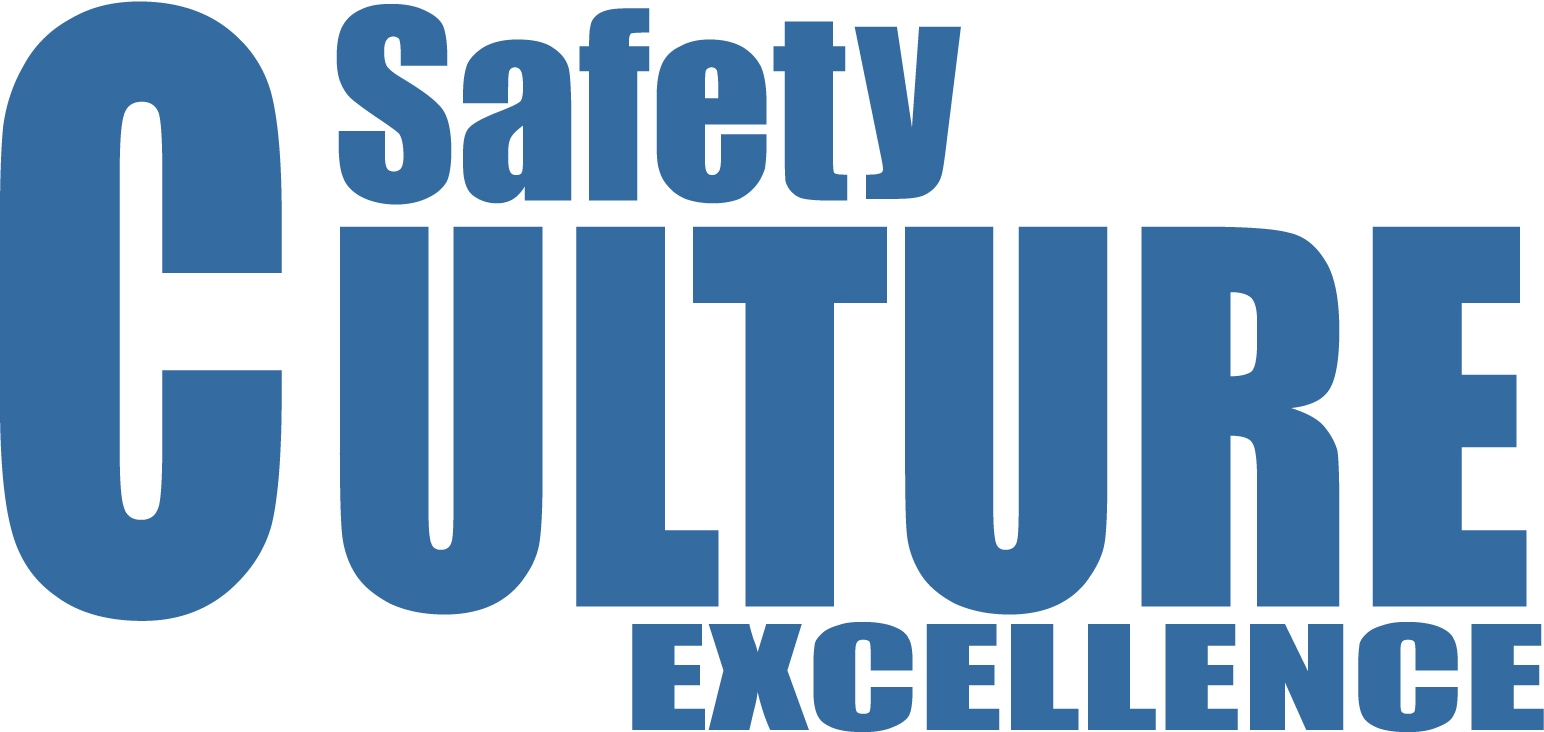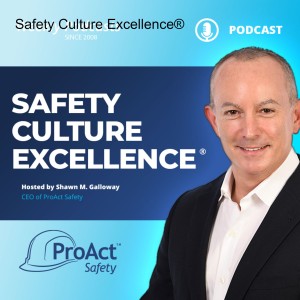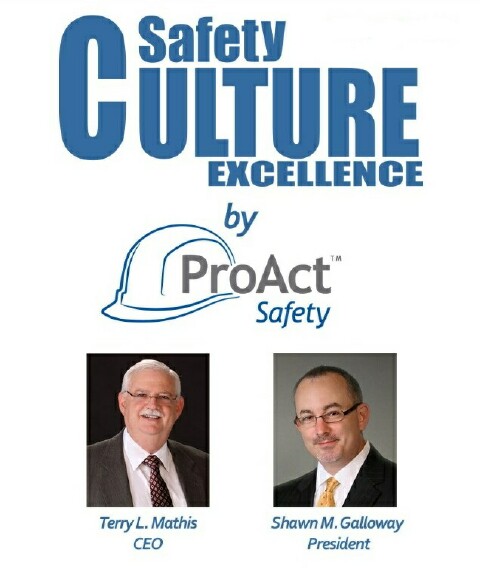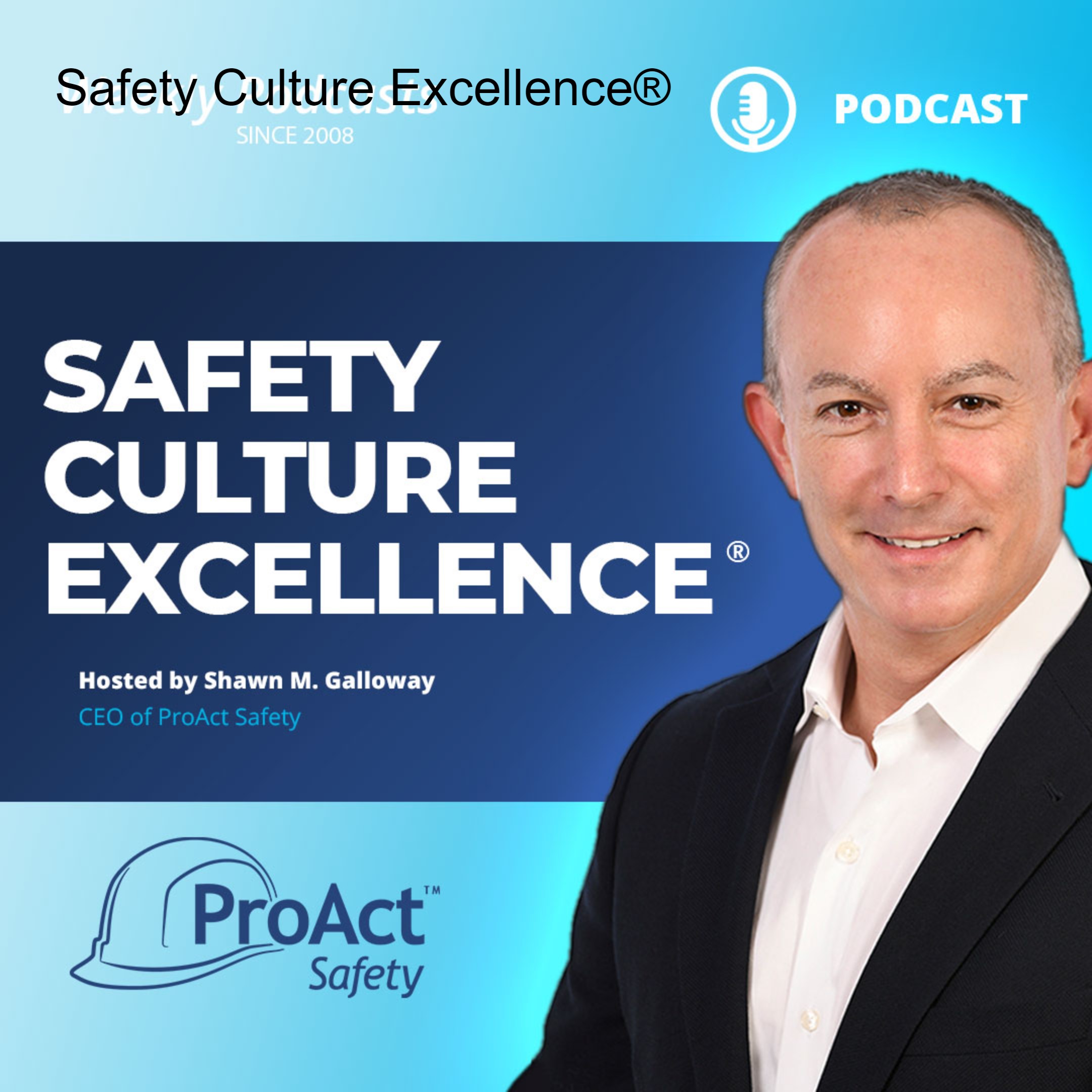Episodes

Monday Feb 17, 2014
328 - Caring More Deeply About Safety
Monday Feb 17, 2014
Monday Feb 17, 2014
Greetings everyone, this podcast recorded while in Clinton, TN. I’d like to share an article Terry L. Mathis wrote that was published January 2014 in EHS Today Magazine. The published article can either be found on the magazine’s website or under Insights at www.ProActSafety.com.
I hope you enjoy the podcast this week. If you would like to download or play on demand our other podcasts, please visit the ProAct Safety’s podcast website at: http://www.safetycultureexcellence.com. If you would like access to archived podcasts (older than 90 days – dating back to January 2008) please visit www.ProActSafety.com/Store. For more detailed strategies to achieve and sustain excellence in performance and culture, pick up a copy of our book, STEPS to Safety Culture Excellence - http://proactsafety.com/insights/steps-to-safety-culture-excellence
Have a great week!
Shawn M. Galloway
ProAct Safety

Wednesday Feb 05, 2014
What is Your Safety Culture Good at?
Wednesday Feb 05, 2014
Wednesday Feb 05, 2014
I just heard another organizational leader claim that he had good safety programs and a good safety culture and couldn’t figure out why he still had accidents. The two greatest problems with such leaders is already stated: they don’t know why they have accidents and they are satisfied that something is good even when it does not produce results.
These leaders are not entirely to blame. They have been told by the “experts” that good safety programs and a good safety culture have certain characteristics. If their programs and safety culture have these characteristics, they must be good ones. The true measure of a safety program or culture is not what it is “like” but “what it can do and does.” If you have too many accidents, your programs and culture are not doing what they should do. If you don’t know why, you can’t lead your organization to better results.
This problem is simply an application of the age-old tendency to mistake activity for results. This is why we have both process metrics and results metrics: so we can see if we are working our plan and also see if our plan is working. A culture that wants to prevent accidents is not automatically a culture that knows how to prevent accidents. Work on your culture’s capabilities and not just its characteristics.
-Terry L. Mathis
Terry L. Mathis is the founder and CEO of ProAct Safety, an international safety and performance excellence firm. He is known for his dynamic presentations in the fields of behavioral and cultural safety, leadership, and operational performance, and is a regular speaker at ASSE, NSC, and numerous company and industry conferences. EHS Today listed Terry as a Safety Guru in ‘The 50 People Who Most Influenced EHS in 2010, 2011 and 2012-2013. He has been a frequent contributor to industry magazines for over 15 years and is the coauthor of STEPS to Safety Culture Excellence, 2013, WILEY.

Tuesday Feb 04, 2014
When Leaders Don’t Lead, Followers Won’t Follow
Tuesday Feb 04, 2014
Tuesday Feb 04, 2014
Insightful conversation from dinner the other night. I was performing a safety culture assessment of an organization in the oil & gas business. While at a restaurant, a man at the next table asked me who I worked for as we were dressed alike. (I was wearing flame-resistant clothing due to the hazardous locations of the field interviews.) Me: “ProAct Safety and you?” Him: Not immediately answering but offering, “Safety’s a bunch of BS.” Me: “I’m... sorry to hear that, what line of work are you in?” Him: “I’m a Superintendent for…” (A known oilfield company, also a Superintendent is often the top local boss on construction and many oilfield projects.)
Me: “Oh yea, okay. So how did y’all do in safety last year?” Him: “Well our rate was …” (It was quite poor). Me: “That’s quite unfortunate, why do you think that is?” Him: “Who knows, probably if our leadership had a better attitude towards it.” Me: “So you are a Superintendent?” Him: “Yea.” Me, with an unfiltered response: “If you believe safety is a bunch of BS, what message do you think that sends to the guys you lead?” His facial expression was the only response I received.
Leaders must remember what they believe will influence their decisions and eventually be observable in their behaviors. If the leaders don’t lead with the desirable beliefs and behaviors, don’t expect the followers to follow. His unfortunate attitude (and possibly those of other leaders if he was correct) might not be the only contribution to their poor performance, but it is certainly a good place to start.
- Shawn M. Galloway
Shawn M. Galloway is the President of ProAct Safety and the coauthor of two books, his latest published Feb 2013 by Wiley is STEPS to Safety Culture Excellence. As an internationally recognized safety excellence expert, he has helped hundreds of organizations within every major industry to achieve and sustain excellence in performance and culture. He has been listed in this year’s National Safety Council Top 40 Rising Stars, EHS Today Magazine’s 50 People Who Most Influenced EHS and ISHN Magazine’s POWER 101 – Leaders of the EHS World and again in the recent, elite list of Up and Coming Thought Leaders. In addition to the books, Shawn has authored over 300 podcasts, 100 articles and 80 videos on the subject of safety excellence in culture and performance.

Monday Feb 03, 2014
327 - Applying the Three As of Employee Engagement
Monday Feb 03, 2014
Monday Feb 03, 2014
327 - Applying the Three As of Employee Engagement
Greetings everyone, this podcast recorded in my home in Texas. I’d like to share an article Terry L. Mathis wrote that was published December 2013 in EHS Today Magazine. The published article can either be found on the magazine’s website or under Insights at www.ProActSafety.com.
I hope you enjoy the podcast this week. If you would like to download or play on demand our other podcasts, please visit the ProAct Safety’s podcast website at: http://www.safetycultureexcellence.com. If you would like access to archived podcasts (older than 90 days – dating back to January 2008) please visit www.ProActSafety.com/Store. For more detailed strategies to achieve and sustain excellence in performance and culture, pick up a copy of our book, STEPS to Safety Culture Excellence - http://proactsafety.com/insights/steps-to-safety-culture-excellence
Have a great week!
Shawn M. Galloway
ProAct Safety

Wednesday Jan 22, 2014
The Org. Chart of Safety
Wednesday Jan 22, 2014
Wednesday Jan 22, 2014
What message does it send where safety is placed in an organizational chart? In some organizations, especially small ones, it may not be significantly consequential. In others, it can be extremely critical. The differences in organizational culture can both dictate where safety should be and suggest where it should not be.
In one of our client organizations, safety, quality assurance and training were all placed under the control of the Vice President of Human Resources. Every individual who had served in that position had come from one of those three backgrounds and was an expert at that one and a complete amateur at the other two. Three VPs in a row were weak in safety and the results emphasized that fact. Two of the “non-safety” VPs had also appointed one of their former associates who also knew little or nothing about safety to head the safety department. We have found similar weaknesses in almost all organizations who do not have dedicated safety professionals at the highest levels or have the president or CEO lead safety personally.
Another client organization had worked diligently to build trust between safety professionals and the represented workforce. They had a history of overusing discipline prior to this effort and were just beginning to overcome it when a senior leader reorganized the senior management group and put safety under the corporate counsel. The immediate perception of the workforce was that the organization was moving back to their old stance on discipline and lining up a lawyer to head the effort. The workers and their union leaders protested.
These are just two examples of how the placement of safety in the org. chart can impact its effectiveness. Unfortunately, there is no magic answer to where it should be for all organizations. An important principle is that safety should be strategically led by organizational leaders and safety specialists should carry out the strategic plan. When safety is delegated to non-safety or multifunctional leaders, it seldom produces excellent performance.
-Terry L. Mathis
Terry L. Mathis is the founder and CEO of ProAct Safety, an international safety and performance excellence firm. He is known for his dynamic presentations in the fields of behavioral and cultural safety, leadership, and operational performance, and is a regular speaker at ASSE, NSC, and numerous company and industry conferences. EHS Today listed Terry as a Safety Guru in ‘The 50 People Who Most Influenced EHS in 2010, 2011 and 2012-2013. He has been a frequent contributor to industry magazines for over 15 years and is the coauthor of STEPS to Safety Culture Excellence, 2013, WILEY.

Monday Jan 20, 2014
325 - Does Poor Safety Equal Poor Management?
Monday Jan 20, 2014
Monday Jan 20, 2014
Greetings everyone, this podcast recorded while in Marble Falls, TX. I’d like to share an article Terry Mathis wrote, published November 2013 in EHS Today Magazine. The published article can either be found on the magazine’s website or under Insights at www.ProActSafety.com.
I hope you enjoy the podcast this week. If you would like to download or play on demand our other podcasts, please visit the ProAct Safety’s podcast website at: http://www.safetycultureexcellence.com. If you would like access to archived podcasts (older than 90 days – dating back to January 2008) please visit www.ProActSafety.com/Store. For more detailed strategies to achieve and sustain excellence in performance and culture, pick up a copy of our book, STEPS to Safety Culture Excellence - http://proactsafety.com/insights/steps-to-safety-culture-excellence
Have a great week!
Shawn M. Galloway
ProAct Safety

Wednesday Jan 15, 2014
The Danger of Relying on Awareness
Wednesday Jan 15, 2014
Wednesday Jan 15, 2014
Awareness is an important part of safety, but it is not the only part. Awareness is simply a step in the right direction that produces nothing without the other steps. Further, there are also two types of safety awareness: awareness of risks and awareness of how to manage those risks. So, when people say that safety is all about awareness, they are missing the big picture.
Consider the following illustration: Two people are traveling in a car and one is aware of the need for seat belts and the other is not. Neither of them buckle their seat belts. They have a head-on collision. Which person hits the windshield hardest, the person who is aware or the person who is not?
The true definition of safety includes two types of awareness and one type of action. Awareness of risks is first. In business we call this risk assessment. Awareness of the ways to address and reduce the risks is second and we call these mitigation and precautions. The third step is the action step. Awareness does not improve safety unless it results in action.
Leaders must mitigate risks where possible. Workers must take precautions where risks still exist. Failure to be aware results in inaction. But inaction can occur even with awareness and can render awareness inadequate to prevent accidents.
-Terry L. Mathis
Terry L. Mathis is the founder and CEO of ProAct Safety, an international safety and performance excellence firm. He is known for his dynamic presentations in the fields of behavioral and cultural safety, leadership, and operational performance, and is a regular speaker at ASSE, NSC, and numerous company and industry conferences. EHS Today listed Terry as a Safety Guru in ‘The 50 People Who Most Influenced EHS in 2010, 2011 and 2012-2013. He has been a frequent contributor to industry magazines for over 15 years and is the coauthor of STEPS to Safety Culture Excellence, 2013, WILEY.

Monday Jan 13, 2014
324 - Stop demotivating safety excellence
Monday Jan 13, 2014
Monday Jan 13, 2014
Greetings everyone, this podcast recorded while in Roosevelt, UT. I’d like to share an article I wrote, published November 2013 in BIC Magazine. The published article can either be found on the magazine’s website or under Insights at www.ProActSafety.com.
I hope you enjoy the podcast this week. If you would like to download or play on demand our other podcasts, please visit the ProAct Safety’s podcast website at: http://www.safetycultureexcellence.com. If you would like access to archived podcasts (older than 90 days – dating back to January 2008) please visit www.ProActSafety.com/Store. For more detailed strategies to achieve and sustain excellence in performance and culture, pick up a copy of our book, STEPS to Safety Culture Excellence - http://proactsafety.com/insights/steps-to-safety-culture-excellence
Have a great week!
Shawn M. Galloway
ProAct Safety

Wednesday Jan 08, 2014
Promoting Safety: When to Talk and When to Shut Up
Wednesday Jan 08, 2014
Wednesday Jan 08, 2014
There is an old saying that “Talk is cheap because supply is greater than demand.” In safety, we find that leaders all too often talk and don’t talk at exactly the wrong times. So what are the right and wrong times to talk about safety?
Wrong Time to Talk: When you don't plan on taking action. Talking about safety issues when no action is being taken damages credibility about as much as anything leaders can do. Have you ever heard a whole work force say “They don’t put their money where their mouth is!”? When talk is not paired with action, there isn’t much to talk about except future plans, and that conversation will set a future trap for leaders if they fail to follow through.
The second worst time to talk is when leaders urge workers to improve safety but have no solid plan for doing so. Saying the awful generalizations like “be careful” and “think before you act” are insulting and meaningless.
Right Time to Talk: When leaders have invested either money, resources or time in safety and have made a difference, it is time to make sure everyone knows. This should not be boasting or grabbing credit, but simply stating that the organization has addressed a safety issue. Failing to let the workers know about significant progress or effort, perpetuates the perception that talk doesn’t match action. It can also ambush workers with unexpected changes in their work place.
Leaders can also set specific behavioral targets and create true talking points. While the tired approaches of preaching generic safety to the troops are often counterproductive, setting improvement goals and defining individual roles and responsibilities in achieving them can truly rally people to meaningful action.
The best safety leaders have learned when to talk and when to shut up.
-Terry L. Mathis
Terry L. Mathis is the founder and CEO of ProAct Safety, an international safety and performance excellence firm. He is known for his dynamic presentations in the fields of behavioral and cultural safety, leadership, and operational performance, and is a regular speaker at ASSE, NSC, and numerous company and industry conferences. EHS Today listed Terry as a Safety Guru in ‘The 50 People Who Most Influenced EHS in 2010, 2011 and 2012-2013. He has been a frequent contributor to industry magazines for over 15 years and is the coauthor of STEPS to Safety Culture Excellence, 2013, WILEY.

Wednesday Jan 01, 2014
Consistency vs. Continuity: Can Either or Both Improve Performance?
Wednesday Jan 01, 2014
Wednesday Jan 01, 2014
Ralph Waldo Emerson commented that “A foolish consistency is the hobgoblin of little minds…” To an extent, every manager and leader has some of this “littleness” of mind. Almost all long for people and process to be more consistent and predictable. If they were more consistent, changes and improvements could be accomplished uniformly across the organization. Sameness smacks of control and what leader doesn’t want to be in control? But the extreme side of consistency is robotic sameness. It contains no original thought, nor creativity. It has no motivation to go above and beyond. It does not question the status quo, nor long for excellence.
Continuity, in its best form, is enough consistency to allow for aligned effort but not stifle it. Continuity of strategy, programs, and terminology allow for individuals to work together toward a common cause with likeness of mind but room for individuality. People can seek the same goals, use the same tools and speak the same language, but do so in their own completely unique way. Each contribution can add up to a much greater sum with such synergy of effort.
So leaders, here is the challenge: Can you lead without micromanaging, align without stifling, create focus without destroying individuality. In short, can you build continuity without going too far and creating little-minded consistency?
-Terry L. Mathis
Terry L. Mathis is the founder and CEO of ProAct Safety, an international safety and performance excellence firm. He is known for his dynamic presentations in the fields of behavioral and cultural safety, leadership, and operational performance, and is a regular speaker at ASSE, NSC, and numerous company and industry conferences. EHS Today listed Terry as a Safety Guru in ‘The 50 People Who Most Influenced EHS in 2010, 2011 and 2012-2013. He has been a frequent contributor to industry magazines for over 15 years and is the coauthor of STEPS to Safety Culture Excellence, 2013, WILEY.

